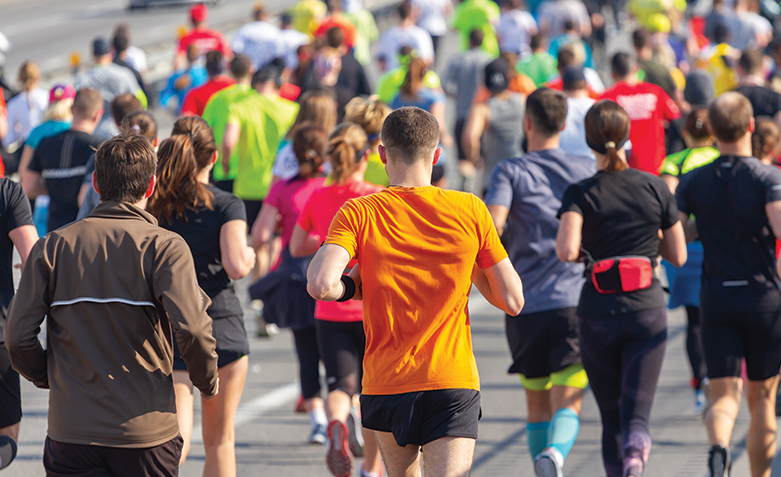
The Ironman Triathlon: A Test of Endurance
An Ironman Triathlon isn’t like any other triathlon you’ve ever completed. Yes, it has the usual three disciplines – a swim, a cycle and a run – but it’s the distance that truly makes it stand out on its own. A full Ironman Triathlon takes place over 140.6 miles (226.2 km) and will see you burn over 10,000 calories and have 130,000 beats of the heart. For many it’s the pinnacle of endurance events and the toughest, most demanding one-day sporting event on the planet.
But with such a demanding race comes the opportunity to raise some serious funds for charity. This is what you need to know about the Ironman Triathlon, and how to bolster your fundraising pot.
Understanding the Ironman Triathlon
The Three Legs of the Ironman Triathlon
The Ironman Triathlon consists of three gruelling legs:
- First up is a 2.4 mile (3.86 km) swim.
- Second comes a 112 mile (180.25 km) cycle.
- And to finish, a 26.2 mile (42.20 km) run.
Yes, that’s right you finish on a marathon. All three legs are completed in the above order, without a break. Most amateur athletes will aim to complete the Ironman Triathlon in around 12-16 hours, so you’ll need some serious preparation to get in shape for an event like this.
A Half Ironman also exists, which is exactly half the distance, clocking in at 70.3 miles. You may want to start off with a half before attempting a full Ironman Triathlon, but it’s really up to you. If you think you can push yourself the full distance, then go for it. Just remember, your training will be key.
Preparation for an Ironman Triathlon

You may consider yourself super fit and you may have experience of triathlons already, but nothing will prepare you for the physical and mental feats of Ironman. Well, other than proper training that is.
Training for an Ironman: What to Expect
Ironman training in itself can be gruelling. Most people start about six months before the race. Anything longer than this and you risk yourself burning out. Training for an Ironman also requires a huge time commitment of around eight to 10 hours a week. With that in mind, you may need to speak to your employer about your flexible time commitments during that time. Your family might need to be a little understanding too.
So, what does Ironman training consist of?
You won’t be surprised to hear that Ironman training involves consistent swimming, running and cycling. Many Ironman athletes choose to work with a coach for their training, but it is possible to do it yourself. If you do choose to do it solo, you’ll need a proper training plan. It also makes sense to get your swimming technique checked with a coach so they can identify any potential weaknesses that you can work on before the race. A professional bike fit will also mean you’re comfortable during training and the big race.
A typical Ironman training programme may look something like this.
Six Months Before the Race
- Monday – 1 hour swim
- Tuesday – 1 hour cycle
- Wednesday – Day off
- Thursday – 45 to 60 minute run
- Friday – 1 hour swim
- Saturday – 60 minute run
- Sunday – 2 to 3 hour cycle
You should gradually look to increase each day’s activity by 10% each week until you hit the four month from race mark.
Four Months Before the Race
- Monday – Day off
- Tuesday – 1.5 hour cycle/1 hour run
- Wednesday – 1 hour swim
- Thursday – 1.5 hour cycle/1 hour run
- Friday – 1 hour swim
- Saturday – 3 to 4 hour cycle/15 minute run off the bike
- Sunday – 40 minute ocean swim/ 1.5 hour run
Again increase by 10% each week, but also give yourself one week where you do slightly less as a recovery week.
Three Months Before the Race
- Monday – Day off
- Tuesday – 1.5 hour cycle/70 minute run
- Wednesday – 1 hour swim increasing distance at session
- Thursday – 2 hour cycle
- Friday – 1 hour swim
- Saturday – 4 to 5 hour cycle/20 minute run off the bike
- Sunday – 45 min ocean swim/1hour 45minute run
Two Months Before the Race
- Monday – Day off
- Tuesday – 2hour cycle/1 hour run
- Wednesday – 4km swim
- Thursday – 1.5 hour ride/ 1.5 hour run
- Friday – 1 hour swim
- Saturday – 6 to 7 hour ride/10 minute run off the bike
- Sunday – 45 minute ocean swim/1 hour cycle/2 hour run
One Month Before the Race
- Monday – Day off
- Tuesday – 1.5 hour cycle/1 hour run
- Wednesday – 4km swim reducing to 3km until taper week
- Thursday – 1 hour cycle/1.5 hour run
- Friday – 1 hour swim
- Saturday – 4 hour cycle
- Sunday – 30 min. ocean swim/1 hour cycle/1.5 hour run
The Week Before the Race
- Monday – Day off
- Tuesday – 2 hour cycle/1 hour run
- Wednesday – 1 hour swim
- Thursday – 45 minute cycle/30 minute run
- Friday – Day off
- Saturday – 20 minute swim/30 minute cycle/10 minute run
- Sunday – Race day. Good luck!
It also makes sense to do a Half Ironman around six to eight weeks before your race to bring a competitive element into your training and give you that all-important race day experience.
Also, you can adapt your training plan to suit your individual needs. If you’re a weaker swimmer but more experienced runner, you can spend more time in the water and less out running. Just remember that running off the bike is very different to standalone running. It can take time to get used to.
Nutrition and Recovery During Training
There’s no doubt about it, your training is going to be intense. Recovery is key, so you must stick to your rest days and don’t do anything on those days. You must also try and stick to your training plan and don’t go over your specific distances each day. Also don’t push too hard at the beginning as you’ll want to build up to the required distances for each of the disciplines.
During your training, you’re going to be drastically increasing your exercise levels consistently for six months. Basically, you’re going to want to eat everything you can get your hands on. But you need to be careful about what you put in your body. You should focus on a good balance of protein, carbs and healthy fat to stay full and well-fuelled for as long as possible.
Your meal after your longer and harder training sessions is your most important as it sets the stage for your next workout. Within 30-45 minutes after training (the recovery window) you should take in 20-30 grams of protein. This is the time your body is most receptive to fuel and it will help repair your muscles as well as mitigate the effects of stress hormones, which are elevated during exercise. It’s so important that you don’t miss this recovery window. If you do, it’s easier to look for quick sugary fixes that don’t help your training.
Outside the recovery window, keep yourself fuelled during the day with lean proteins, good fats, fruit and vegetables, and complex carbs like potatoes, rice and whole grains.
You must also keep yourself properly hydrated throughout the day, and not just when you’re training.
Ironman Triathlon UK: Key Locations and Events

Keen to get signed up to an Ironman Triathlon in the UK? Here’s what you need to know.
UK Ironman Events
In the UK in 2023, there are seven Ironman events being run. They are:
- The Northumbrian in Hexam, Northumberland: 2 July
- Ironbourne in Eastbourne, East Sussex: 9 July
- 11th Midnight Man in Dartford, Kent: 12 August
- The Long Course Weekend in Tenby, Wales: 30 Jun
- IRONMAN UK in Bolton, Greater Manchester: 2 July
- IRONMAN Wales in Tenby, Wales: 3 September
- Do3 Black Long Distance Weekend in Compton Verney, Warwickshire: 22 July
Notable Ironman Courses in the UK
The two most notable Ironman races in the UK are IRONMAN UK and IRONMAN Wales. The UK event is held in Bolton, where the race is known for its stunning scenery on the bike course and iconic finish line in the heart of the town centre. It is also England’s only full-distance Ironman, and is famed for its spectator support.
IRONMAN Wales is held in the South Wales seaside town of Tenby in Pembrokeshire. The unique swim happens on the town’s sandy beach, the bike takes in wild scenery along the Pembrokeshire coastline, culminating with the run in the fan-filled town centre.
Raising Money for Charity through Ironman Participation
Pushing yourself to the limit in an Ironman Triathlon, is a fantastic opportunity to raise money for a good cause. If people know you are putting everything on the line with such a gruelling challenge in the name of charity, they will likely get behind your efforts with sponsorship.
The charity you choose to support is up to you, but many Ironman athletes compete for causes like Help for Heroes and other charities that support the military and first responders. Often they want to honour people that put their lives on the line by pushing themselves through the pain barrier.
As well as setting up a fundraising page on the likes of JustGiving or GoFundMe, you can also raise money for your cause through easyfundraising. It’s super simple and all you need to do is sign up your fundraising efforts as a good cause on our website. It’s free to do.
Once you have, people can donate to you as they go about their normal online shopping. They can shop with more than 7,500 online retailers after selecting your fundraising efforts as their chosen good cause. Once they spend with a specific retailer, the retailer will then make a donation to you on their behalf. You’ll have your own personal dashboard where you can check how many supporters you have and the donations you’ve secured.
To raise as much as possible, you’ll also want to spread the word and get people to buy into your fundraising story.
When you create your page, think about the language you use. How can you create a compelling story? Detail why you’re doing an Ironman Triathlon, how tough it’s going to be and why the charity means so much to you. If you give people a reason to believe, they’ll be more likely to back you.
You can also showcase your fundraising goal on your dedicated easyfundraising page, so your supporters can see how close you are to your target. And don’t forget to promote it on social media to build awareness – you’ll find helpful templates to do just that in our handy ToolKit.
Embracing the Ironman Challenge
There’s no doubt about it, the Ironman Triathlon is one of the biggest challenges (if not the biggest) you’ll ever face. It pushes your body and mind to the limit across 140.6 miles. Once you’ve done a gruelling swim and cycle, you then have to go on and complete a marathon! But the feeling of achievement and elation when you cross that finish line can’t be matched. Your training will push you to the limit across six long months. You’ll need to eat right, recover right and follow your training schedule to the letter to be in the right shape come race day. But try to enjoy it along the way too.
And with such a challenge comes a huge opportunity to raise some funds for charity. Just don’t forget to sign up to easyfundraising for a simple way to boost your donations during training and in the lead up to the race.
